4
Fashion consumption
download
teacher's notes
What kind of consumer are you?
> Grade: 7th to 9th
> Subjects
- Entrepreneurship
- Sustainability
- Globalisation
a. What is fast fashion?
b. fashion industry, good or bad?
A
What is fast fashion?
VIDEO
Cynthia is a Canadian 20 year-old. 2 years ago she realised she was not happy about the kind of consumer she was:
"Not long ago, I realized how unhappy I was with my wardrobe. It was a major stress in my life because the pieces I had were not versatile and didn't represent my style. It didn't make sense to me, until I made the connection to my shopping habits and consumption patterns -- it all came down to the fact that I was never shopping for the right reasons."
Discussion
After watching this video, is the fashion industry good or bad for:
Workers in factories?
Consumers?
Shareholders of the brands?
Designers?
THEORY
The Rana Plaza incident
On 24th of April 2013, over 1,130 people were killed when the Rana Plaza factory complex collapsed in Dhaka, Bangladesh. 2,500 more were injured. The people crushed under those 8 floors were working for familiar fashion brands in one of the many negligent accidents that often happen in the garment industry.
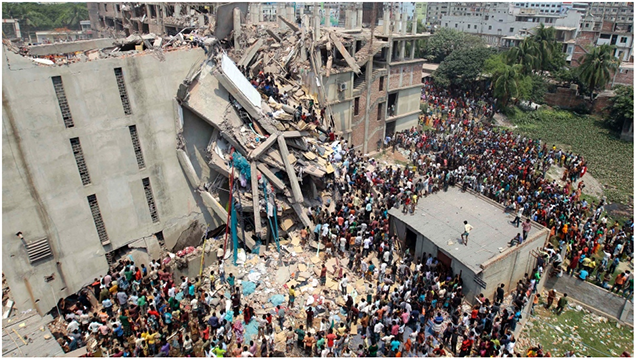
Copyright CTV News
The Rana Plaza incident brought public attention to the lack of transparency in the fashion industry supply chain. It also made consumers suddenly aware of the consequences of buying fast fashion. After the Rana Plaza incident, fashion consumers started asking brands for more information about how their clothes are made. Consumers around the world have started asking questions and demanding a change in the fashion industry.
So what has changed since the Rana Plaza building collapsed?
negligent
adj.
not being careful or giving enough attention to people or things that are your responsibility.
Comprehension questions
1. How many textile workers died in the collapse?
2. Was the accident preventable?
3. Why were the workers in the building when cracks had already been reported?
4. How is this and other disasters connected to fast fashion?
5. What other negative effects does fast fashion have?
VIDEO
The fashion industry is producing more and more clothes every year. That means we are buying more and more clothes every year. We buy more because it is cheap. But the reason those clothes are cheap is that the materials are cheap and bad quality, and, the people that made the garments are not being paid enough money.
As consumers, is there any way of buying things that are made in a more conscious way? Are we ready to pay more for better quality?





B
Fashion industry, good or bad?

THEORY
Below these lines you can find 4 different articles that have a connection with the Rana Plaza collapse.
A. What's wrong with the fashion industry?
B. The rise of mending
C. Millennials for change
D. Fashion revolution
Remember you can share any criticisms you have of the texts you read, especially if your criticisms are specific and constructive.
a. What's wrong with fashion?
b. the rise of mending
c. Millennials for change
d. Fashion revolution
Can Fast Fashion Really be Sustainable?
by Raz Godelnik on Tuesday 29th, April 2014 for triplepundit.com
"Why your $8 shirt is a huge problem" by GRIST
Last Thursday marked the one-year anniversary of Bangladesh’s tragic Rana Plaza factory collapse, where 1,130 garment workers were killed.
“If a positive can be found, it’s that Rana Plaza has been a turning point — the 21st Century equivalent of New York’s 1911 Triangle Shirtwaist factory fire, which killed 146 but led to a unionized, safe garment industry,” Dolly Jones wrote on Vogue earlier this month.
This tragedy resulted indeed in significant steps taken by individual companies and European and American coalitions, aiming to improve the safety of the garment workers in Bangladesh and ensure clothing supply chains are more ethical and transparent.
Still, even with all of these efforts to build what H&M describes as “sustainable fashion future,” one question is still hanging out there: Can fast fashion really be sustainable?
To answer this question let’s try first to define what fast fashion is and why exactly it is unsustainable. “The phrase ‘fast fashion’ refers to low-cost clothing collections that mimic current luxury fashion trends,” the authors of the paper “Fast Fashion, Sustainability, and the Ethical Appeal of Luxury Brands” explain. “Trends run their course with lightning speed, with today’s latest styles rapidly outdoing yesterday’s, which have already been moved to the trash bin.”
The speed of fast fashion, the cheap prices and the poor quality of many items have gained it the nickname “McFashion.” Other terms used to describe this trend are even less compelling, including “landfill fashion” to “throwaway fashion” and “cheap crap.”
Supply Chains
Entire network of entities, directly or indirectly interlinked and interdependent in serving the same consumer or customer. It comprises of vendors that supply raw material, producers who convert the material into products, warehouses that store, distribution centers that deliver to the retailers, and retailers who bring the product to the ultimate user.
mimic
verb.
to imitate or copy in action, speech, etc., often playfully or derisively.

dispute
verb.
to engage in argument or debate.
planned obsolescence
Planned obsolescence is a manufacturing decision by a company to make consumer products in such a way that they become out-of-date or useless within a known time period. The main goal of this type of production is to ensure that consumers will have to buy the product multiple times, rather than only once.
Fast fashion companies tend to see it differently of course. From their point of view this trend is about making fashion accessible and affordable for more people. “We want to surprise the customers,” Margareta van den Bosch, H&M’s style adviser told NPR. “We want to have something exciting. And if it’s all the time hanging the same things there, it is not so exciting, I think.”
What fast fashion companies would probably not dispute is that their affordable prices require them to manufacture in countries where the wages are low and sell high volumes of items, utilizing planned obsolescence tactics to be profitable. And this is where the problem lies.
High volumes requires a greater use of raw materials, energy, water and other resources and contributes to climate change – the U.K.-based organization WRAP estimated that “the processes from raw material to garment supply contribute around one-third of the waste footprint, three-quarters of the carbon impact and most of the water footprint of clothing.” According to WRAP’s research, extending the average life of clothes by just three months of active use per item would lead to a 5 percent to 10 percent reduction in each of the carbon, water and waste footprints.
In addition, keeping prices low requires fast fashion companies to manufacture in countries with low wages, where contractors and subcontractors need to meet requirements for low costs, many times on the account of workers’ safety and working conditions, just like we saw in Bangladesh.
Finally, let’s not forget the cultural impact fast fashion has on consumers – it has promoted the trend of disposable fashion, where customers buy items and because they’re so cheap they use them just once or twice before discarding them. This is not always the case – I’m writing this article wearing my beloved Zara shirt that I bought in 2004. Still, reading that a research by the American Apparel and Footwear associations found that “Americans annually purchase an average of eight pairs of shoes and 68 pieces of clothing,” I get the feeling that my Zara shirt is the exception, not the rule.
So, given these unsustainable impacts you can see that making fast fashion sustainable seems almost impossible. After all, when thinking about companies built on sustainable principles like Patagonia, Zady and Honest by, it seems like sustainability is everything fast fashion isn’t. As Rose Marcario, Patagonia’s new CEO explained it in an interview with the Guardian:
“If you build things that last, [customers] need to buy less of them and you deplete fewer natural resources. We think that’s a good thing…we are facing an ecological disaster – and if we continue this idea of fast fashion and throwing away products, not recycling and not taking care of environment, we are not going to have a planet to live on.”
Still, fast fashion companies claim Patagonia’s way is not the only way to be sustainable. They also offer a vision that is supposed to improve their practices and create a more sustainable business model. It is based on elements such as ensuring fair living wage and better working conditions for garment workers, and creating a closed-loop systems, where customers are encouraged to bring back unwanted clothes, which will later be used as textile materials in new products.
These are not perfect solutions, especially when it comes to creating closed-loop systems, which require customers’ collaboration and further technological advancements to become a viable solution. As the Guardian’s Oliver Baich wrote “closed-loop textile recycling currently remains exactly that: a promise.”
In my point of view the problem with the closed-loop solution is not just its feasibility, but also that it’s basically about being less bad, or “making the old, destructive system a bit less so,” as Michael Braungart and William McDonough describe such efforts in “Cradle to Cradle.” And “doing less bad is not the same as doing more good,” they add.
So what is “doing good” in the case of the fast fashion industry? This is a mindset shift from economics that is wasteful and based on selling a large number of low-quality products to economics that is mindful and based on selling less yet better products. The challenge as Oliver Baich wrote is to move from creating happy shoppers to creating happy non-shoppers, ones that use their garments more frequently, share clothes and buy less.
If and when fast fashion will be able to make this change, then it will become sustainable. Until then, all we have are attempts with little impact to slow it a bit.
Copyright www.teinteresa.es
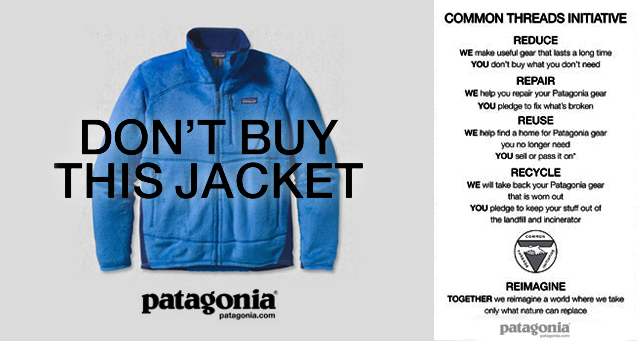
Copyright by Patagonia.com
questions
1. Make a little summary to explain your classmates what Fast Fashion means.
2. Define what are the ethical and environmental problems of the fast fashion system and consumption.
3. Create a presentation (PPT, Keynote or any other format) to explain the two points above.

The rise of mending: how Britain learned to repair clothes again
credits
This article was originally published here.
By Sarah Lewis-Hammond - for theguardian.co.uk
Monday 19 May 2014
When Make Do & Mend (“we make things and mend things,” says Pippa Bray, the shop's owner) opened its doors in 2002, they had expected to be reasonably busy. That turned out to be an understatement. They weren’t just busy, they were inundated, getting busier all the time. And then the economic crisis arrived – and business went through the roof.
“When the recession hit, people became more conscious of cost and started valuing their clothes more. We do a lot of replacing zips, taking up hems, altering old clothes to fit,” says Bray. The shop, in St Day in Cornwall, now employs 12 people, and turns out a constant supply of fixed pockets, patched jeans, relined jackets, and taken up hems. While the small jobs are the bread and butter of the business, they have also on request expanded into upholstery, marine-ware (such as boat covers and cushions), and even academic gowns for university graduates.
According to Pippa, it’s a huge growth industry but there are not enough skilled people. “I’m always being asked to show people how to put in a zip or patch jeans. It’s just not taught anywhere any more. Good clothes are like old friends and it’s nice to see when people don’t have to throw away a jacket or something they’ve had for 20 years.”
hem
noun
The edge of a piece of cloth or clothing which has been turned under and sewn.
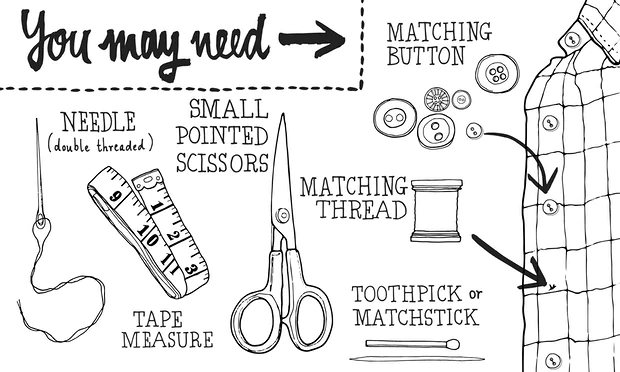
How to sew a button. Copyright by guardian.co.uk
Making or altering clothes may seem like a humble pursuit. But research by the Craft & Hobby Trade Association (CHA-UK) shows that the entire crafting industry (which also includes knitting, cake decorating, painting and other handycrafts) is worth a whopping £3.1bn to the UK economy. It is also, as if from nowhere, wildly popular. About 3.5 million people in the UK are involved in making their own clothes with a sewing machine according to CHA-UK, and of that number 433,000 only started sewing in the last 12 months.
“The last few years have been epic for the industry,” says Fiona Pullen, founder of the Sewing Directory and described by some as the godmother of the sewing world. She thinks the economic crisis has driven people towards a more Make Do & Mend mentality, and growing environmental awareness is making people more conscious of where their clothes come from. “People are trying to be less disposable. They would rather buy something quality and keep repairing it. The Great British Sewing Bee helped a lot [John Lewis has seen a 22% increase in sewing machine sales since the show ran last year] . It was already happening.”
Tom van Deijnen runs the Visible Mending programme in Brighton and has a mission to show that repairs to clothes can in themselves be beautiful. “Wear your darn like a badge of honour,” he says. When he takes on a commission he asks, “Why would you like me to repair this? What makes you want to keep it?”
humble
adj.
Having or showing a modest or low estimate of one's importance.
disposable
adj.
intended to be thrown away after use.
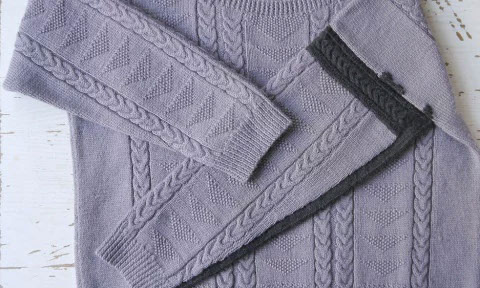
Tom van Deijnen – "Wear your darn like a badge of honour". Photograph: Tom van Deijnen
“I started repairing because I realised there is a lot of work and skill involved in making clothes. It takes a long time. I began to appreciate the skill and effort all these anonymous people put in to making clothes for the high street. If you want to make people understand why £4 for a T-shirt is not the right price, get them to make an item of clothing. We should respect them for making these clothes for us, especially at the prices we pay.”
Although the mending movement is still small, Tom says it is growing and people are coming round to the idea that you can’t just throw things out any more, you need to fix them. He points out that Repair Cafés, where you can turn up with anything from a wonky chair to a smashed smart phone and find out how to fix it, are becoming increasingly common. “People are starting to see the importance of repairing again,” he says.
“They don’t teach sewing in most schools nowadays, or mothers don’t get a chance to teach them, or they’re frightened, they think the machine is going to run away with them,” says Mary Ann Robbins, who runs workshops around Buckinghamshire and Hertfordshire under the name Sewing Seams Easy, teaching people how to use a sewing machine and to refashion old clothes. Over the last couple of years her business has grown dramatically.
Dressmaking and refashioning has also seen a huge upsurge in interest, partly, according to sewing blogger Rachel Pinheiro, thanks to the internet. “The techniques of sewing are the same now as they were 100 years ago. There is nothing new when it comes to making things. But over the last few years people have begun to find each other and share ideas as they have never been able to before. There are fresh ideas in terms of design and colour, and a change of aesthetic. It’s brought a whole new audience to the hobby.” Sewing and mending communities are springing up and forming networks via Twitter or Pinterest, through innovations like #makedoandmendhour, where every Thursday evening Jen Gale of the My Make Do and Mend Year blog, hosts a hashtag-based hubbub of ideas, jokes, and requests for mending advice.
wonky
adj.
Not straight; crooked or askew. Unsteady.
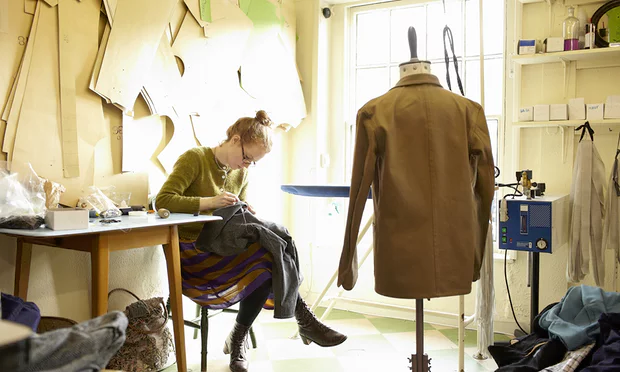
The demand for mending services has skyrocketed.
“It really is a wonderful community to be a part of,” says Pinheiro. “That’s one of the great attractions of sewing, it’s the people. We joke there is a special sewing gene that makes that person immediately friendly.”
For Fiona that community has been the bedrock of her new career. The Sewing Directory was meant to be a minor pastime that fit around her young son, but the sudden explosion in popularity means it has taken over. “I work 60 hours a week,” she says. “I could take on people and work seven days a week but there is still more work.” Her success has also opened other opportunities: she now trains other craft businesses in the dark arts of SEO and marketing, she writes regularly for sewing magazines, and has just finished her first book, a guide to running a creative business. “It’s not just me,” she says. “Lots of my customers are so busy.”
“Sewing is empowering,” says Rachel. “Not just in terms of creativity, but it also allows you to share knowledge with others, to make friends around the world and experience their culture. The internet is like a chemical agent for speeding everything up. Whatever is going on in the world, the sewing community responds somehow.”
On 14 April, for example, the anniversary of the Rana Plaza tragedy in Bangladesh, people wore their clothes inside out to show the labels, to show they weren’t supporting the companies implicated in the disaster. Rachel says “people who sew their own clothes have their own labels. We can say ‘this is made by me’, the exact opposite of the mass manufactured industry.”
That is a kind of satisfaction that can’t be beaten. “People want the satisfaction of being creative,” Rachel says. “But life is also busy and this is a way people can find each other, they can find their club.”
bedrock
adj.
The fundamental principles on which something is based.
questions
1. Make a little summary of the text to explain your classmates what this text is about.
2. Research how many repair shops and workshops are around your city. Make a small map with all of them and a list of their next workshops.
3. Create a presentation (PPT, Keynote or any other format) to explain the two points above.
1.
philanthropy
noun.
the practice of giving money and time to help make life better for other people
2.
boomer
noun.
a person born during a baby boom
3.
coddled
noun.
to be treated with too much care or kindness
Millennials Are Reshaping The World Of Social Impact
By Vanessa Kirsch and Dana O'Donovan
www.fastcoexist.com
January 2016
Stories about millennials are unavoidable in the media today. We’ve all heard how they’re knocking at the door to the corner office and already taking the lead in politics, business, philanthropy, and everywhere else. Like the boomers in their day, millennials will be the largest proportion of any generation in the U.S. workforce by 2025, and their unique set of characteristics will reshape our world. But too often, their uniqueness is being viewed with apprehension, as the entire demographic is painted with critical terms like self-centered, careerist, apathetic, coddled, materialistic, and unfocused. The suggestion seems to be that they aren’t up to meeting the challenges we face as a nation and a world. Even more problematic, when it comes to marketing products, the term "millennial" has become almost synonymous with the narrow slice of the larger generation who is white and upwardly mobile.
We beg to differ on both points, because we’ve seen what millennial leaders are capable of. Our two organizations, the nonprofit venture philanthropy fund New Profit and the professional services firm Deloitte, have collaborated for 15 years to help visionary social entrepreneurs build high-impact organizations and problem-solving ecosystems, with a goal of breaking down the systemic barriers standing between people and opportunity in America. We have seen every type of leader, organization, and approach during that time, so we’re rarely surprised. But recently, we’ve been amazed to meet millennials from diverse backgrounds and sectors who are fearlessly ignoring the negative chatter about their generation and instead are showing us the future. We want to introduce you to a few people and groups that show how this unique generation is already changing the way we live, work, and solve problems:
1. Vedette Gavin and Derwin Dubose, New Majority Community Labs (NMCL)
Created to shift power from social sector institutions, most of which lack demographic and socioeconomic diversity, to people and communities, NMCL uses the power of big data to amplify the effectiveness of on-the-ground organizing. As cofounder Vedette Gavin said recently, "Don’t create a plan to help me without including me!" NMCL hires people in communities to collect and analyze data, then works with them to create locally led, locally funded solutions. While still in the seed stage, NMCL has already launched a program in the under-resourced Ivy City neighborhood of Washington, D.C. And bigger expansion plans are in the works.

Copyright fourhooks.com
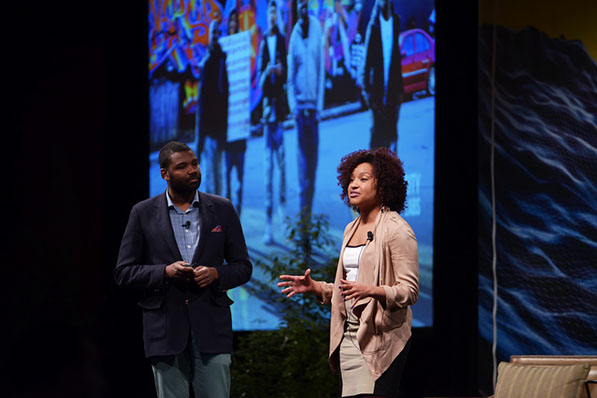
4.
insightfulness
noun.
having or showing a very clear understanding of something
2. The MBA students at the Deloitte Foundation’s national case competition
For the first time this year, the Deloitte Foundation focused its annual case competition on social impact, asking MBA students to craft a new organizational strategy for New Profit, rather than the classic profit-oriented corporate puzzles. The students were given less than 12 hours to immerse themselves in complex issues relating to the evolution of philanthropy and the social entrepreneurship movement and prepare a presentation for senior leaders from Deloitte and the social impact community. We were absolutely amazed at their insightfulness, energy, and passion.
3. Alejandro Gac-Artigas, Springboard Collaborative
With a mission to close the reading achievement gap, Springboard Collaborative takes a unique in-sourced staffing approach by training public school teachers to collaborate with parents on reading achievement, using an ingeniously inexpensive approach that works within existing budgets to build lasting internal capacity in schools. Springboard Collaborative is truly redefining parent-teacher collaboration and, in turn, transforming school communities and optimizing student-learning outcomes.
Copyright by www.newprofit.org/

This is just a sampling of what we’ve seen among millennials who are taking different routes toward social impact in different sectors. Contrary to the critics, we see three traits in common across the best and brightest of this generation that give us good reason to believe in their ability to make real headway on deeply rooted social challenges:
MILLENNIALS UNDERSTAND THAT SOCIAL PROBLEM SOLVING IS COLLABORATIVE AND MULTIFACETED
The venture philanthropy movement, and much of philanthropy more broadly, has long been focused on finding and scaling great nonprofits as an avenue to systemic change. This is an important approach, but we’ve found that it doesn’t go far enough or fast enough to solve big problems. The philanthropic sector, with more millennials involved, is now starting to work in partnership with others from government and business, putting more focus on collaborative, cross-sector approaches.
MILLENNIALS DO NOT RECOGNIZE THE WALLS BETWEEN SECTORS
They are pursuing social impact wherever they are, starting organizations that blur the lines between for-profit and nonprofit, making values-driven buying decisions, and looking at cross-sector collaboration as required for social problem solving. It’s almost as if there never had been an assumption that driving social change was only the job of the social sector.
MILLENNIALS PRIORITIZE SUBSTANCE (IMPACT) OVER STYLE
In a social media-driven world where millennials seem to flock to the flashiest new product or trend, we are inspired to see how millennials also focus so sharply on impact. Millennials make decisions based on personal values first and foremost, and the pursuit to maximize impact is at the center of what shapes all of their thinking and choices.
All of this points to millennials holding considerable potential for shaking up our pursuit of social impact in a very good way. Where today’s world has scattered experiments in new models that we know to have potential—efforts to put outcomes ahead of organizational missions, pursue multipronged solutions, seamlessly combine the strengths of all sectors, and manage even profit-seeking organizations based on strong values—millennials are poised to learn from those experiments and make them the norm.
As we strive to make America a more equitable playing field, how can we not only invent new models but also improve the structures that already stand? That is a question that, more than any other generation, millennials need to lead the way in answering.
questions
1. Make a little summary to explain your classmates what this text is about.
2. Define what social innovation is and find two examples of social innovation in the fashion industry.
3. Create a presentation (PPT, Keynote or any other format) to explain the two points above.

Why do we need a fashion revolution?
Extract from "It’s time for a Fashion Revolution"
White Paper Report by Fashion Revolution
December 2015
On 24 April every year, Fashion Revolution Day brings people from all over the world together to use the power of fashion to change the story for the people who make the world’s clothes. We want fashion to become a force for good.
Fashion Revolution was born on the day that Rana Plaza collapsed. This disaster acted as a
metaphorical call to arms. 1,130 is too many people to lose from the planet in one factory, on one
terrible day without that standing for something. We believe that the cost of fashion shouldn’t be
someone’s life. We mustn’t allow tragedies like Rana Plaza to remain an unfortunate reality of
contemporary life. Today, both people and the environment are still suffering as a result of how
fashion is made, sourced and purchased. We believe enough is enough.
Though the Rana Plaza disaster is no longer on the front pages of the news or at the forefront of our minds, we believe it has opened up a window for significant change in the industry. Whilst this tragedy is a symptom of industry-wide problems, it gives us an opportunity to set a new agenda to overcome the causes. The public must be part of setting this new agenda for the fashion industry.
However, change will need to come from multiple angles — business, consumers, governments, academia, NGOs and others coming together to create a safer, cleaner, more just and fair future for fashion. Before we set out what changes need to happen, let us first look broadly at the way in which our clothing is made today, how it came to be made in this manner and what big problems have resulted from the way the fashion industry works. We wanted to put a wide lens on the issues below, so you have an overview of what we’re talking about when we say we need a fashion revolution. Though, of course, this doesn’t cover everything. There are many organisations that have been working on these issues for years and have made some important in-roads into improving conditions and solving some of the problems that the fashion industry faces. There is also a long list of multistakeholder groups and government interventions that have paved the way for Fashion
Revolution’s work, without which it would be impossible to contextualise the Rana Plaza disaster.
Human rights and working conditions
Despite a number of international standards, certifications and government legislation to tackle
human rights, working conditions are not up to scratch in many of the places where clothing,
accessories and footwear is made. Systematic exploitation remains rife. Human rights violations
include cross cutting issues such as forced and child labour, repression and discrimination, and
unsafe, dirty and unfair working conditions.
Producers and garment workers might face excessive hours, forced overtime, lack of job
security, denial of trade union rights, poor health, exhaustion, sexual harassment, discrimination
and denial of other basic human rights when on the job. These problems exist not just in places like Bangladesh but also in developed countries like the United Kingdom and the United States.
Thanks to the pioneering work of international NGOs and unions like Better Work, CARE, Clean Clothes Campaign, Fair Wear Foundation, Fairtrade International, IndustriALL, Labour Behind the Label, Oxfam, TRAID, Traidcraft, War on Want and many others dedicated to improving the garment industry, human rights issues are more visible and better understood than ever before. These organisations have made significant in-roads into improving conditions for many of the world’s producers.
However, the harsh reality remains that basic healthy and safety measures do not exist for huge
numbers of people working in fashion’s supply chains. The Rana Plaza factory collapse is the most
extreme and familiar example. Since Rana Plaza, the Bangladesh Accord, set up to improve factory
conditions, has inspected over 1200 factories for safety hazards and as a result has closed 41 and
helped to upgrade many others. But this is just one country where our clothing is made.
There are many other human rights abuses at play in fashion’s supply chains. For example,
Labour Behind the Label has found that mass fainting of garment workers in Cambodia is due to
malnutrition. The International Labor Organisation (ILO) finds that women are most often, but not
exclusively, the target of sexual harassment.
Better Work data shows that men are three times more likely than women to be supervisors. Women are less likely to be promoted, receive training or become a union leader. According to the ILO, there are 215 million children working throughout the world, many full-time. Of these, 115 million are exposed to hazardous forms of child labour. In Maplecroft’s Child Labour Index, India ranked 1st with over 14 million children in work, mainly in textiles. Their research underlines the fact that the issue of child labour is often symptomatic of a range of underlying structural problems in a country, including poverty and a lack of access to education.
Overconsumption
Not only has production moved mass-market but the way we consume clothing has changed a lot over the past 20-30 years too. We buy more clothes than we used to and spend less on them. A century ago, we spent more than half our money on food and clothes, today we spend less than a fifth. (The Atlantic, 2012). Yet as a society we purchase 400% more clothing today than we did just 20 years ago (Forbes, 2014). Today over 80 billion garments are produced each year (Greenpeace).
The average American buys 64 items of clothing a year. In the UK alone 2.15 million tonnes of clothing and shoes are bought every year (University of Cambridge, 2006) yet UK citizens have an estimated £30 billion worth of unused clothing sitting in their closets (WRAP, 2012).
Today, the seasonal calendar has been dramatically sped up. For decades, fashion collections were
produced twice a year: Spring/Summer and Autumn/Winter. Now we have resort or cruise collections and pre-collections aiming to cash in on a growing global wealthy class. On the high street, new collections now hit the shelves every week or two. We’ve come to a point where the fashion industry works on a relentless drive for speed and with it comes mounting waste and overconsumption.
Clothing typically stays on the racks fewer than 12 weeks before being marked down on clearance.
Designer Carrie Parry tells The Guardian: “Shoppers have become so accustomed to these markdowns that it’s creating a vicious cycle of overconsumption, paired with lower margins for both brands and retailers as they find themselves saddled with overstock and forced to discount slow-selling merchandise.” Yet none of this reflects the true cost of fashion. Countless reports have indicated that the cost of labour is now rising in China, the world’s biggest apparel and
textiles producer. Cotton prices are also on the rise. The costs of fertilisers and farm machinery are rising too. The chemicals used in dyes and other treatments used for fashion products are getting more expensive too. Yet what we pay for clothing is still cheaper than ever. It begs us to ask why. Who is getting squeezed?
We believe it is the millennial generation that is driving this shift in thinking.
McKinsey (2013) estimates that millennials will account for one third of total global spending by 2020 and already account for one quarter of the U.S. population who together wield about $200 billion buying power. Although millennials will soon be the largest consumer generation in history, young people have a different outlook than previous generations.
Elite Daily interviewed 1,300 millennials and 75% said that it’s either fairly or very important that a company gives back to society instead of just making a profit. JamieGailewicz wrote in The Next Web (29 March 2014): “millennials are children of the ’80s and ’90s—most becoming aware of their impact on society in the late ’80s through the early ’90s. They learned about responsibility to the environment, tolerance and acceptance of others, and that an individual can make a difference. Millennials are the recycling generation, raised on the idea that sorting garbage minimizes waste. They learned about global warming and how dependency on fossil fuels can have a dire effect on the world. They were taught to be conscientious of what they consume and how they live in a way that generations before them were not.” Millennials are a technology-driven generation.
Social media is an integral part of their everyday life. Mobile phones and Internet access lets information travel faster than ever before. The digital space allows for people to be more engaged with brands and governments alike. Technology makes it possible for more voices to be heard. Fashion Revolution is tapping into this, using the power of the Internet to change more mindsets, to ask questions, to debate the issues to demand more transparency about the products we buy.
Picture by labs.theguardian.com/unicef-child-labour
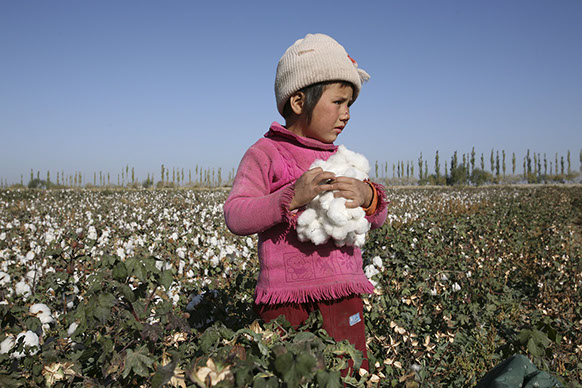
credits
This is an extract of the Report White Paper published by Fashion Revolution in December 2015. You can find the full report here.
1.
source
noun.
to contract a manufacturer or supplier
2.
up to scratch
at an acceptable standard or quality
3.
rife
adj.
very common and often bad or unpleasant
4.
dire
adj.
a: very bad, causing great fear or worry.
b: warning of disaster, showing a very bad future.
c: requiring immediate action, very urgent
questions
1. Make a little summary to explain your classmates what Fashion Revolution is about.
2. Choose three organisations from the text highlighted in red and prepare a small presentation about the for your classmates.
What are this organisations doing to create a more fair fashion industry?
Where do they operate?
3. Create an infographic to present in class with all the information in the section: "Overconsumption".
Now you've learned about fast fashion!
POWERED BY





